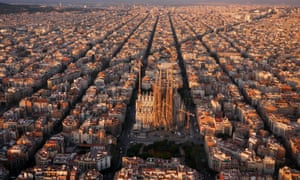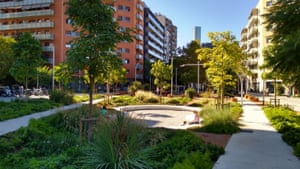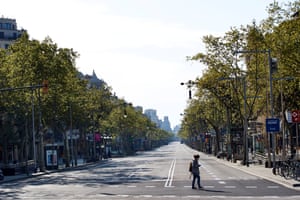At the turn of the 20th century, the Catalan engineer Ildefons Cerda had a revolutionary idea for extending Barcelona beyond the cramped confines of its medieval walls. In the grid system of the extension he planned, each city block would be built around a large open space or patio, designed to be a park for residents.
When he began his work, the old city was hemmed in physically and psychologically, desperately overcrowded and disease-ridden, with frequent outbreaks of cholera and a lower life expectancy than London or Paris.
Cerda, whose ideas on urban planning were radical at the time, in effect designed a new city with broad streets and open spaces. The Eixample, as the extension became known, now makes up most of central Barcelona, but 100 years on, nearly all of Cerda’s patios have been paved over for commercial use and Barcelona is once again one of Europe’s most densely populated cities.

Its 1.6 million people live crammed into a small space between the sea and the mountains, bound to the north and south by rivers, and overspilling into satellite towns that take the metropolitan population to around 5 million. There is almost no breathing space.
In fact, its citizens breathe air that consistently exceeds EU and WHO limits for nitrogen dioxide (NO2) and PM10 particulates, and according to the World Economic Forum the city also has the worst noise pollution in Europe.
The culprit in both cases is the car, not industry. The city has the EU’s highest density of cars, with 6,000 per square kilometre. Private vehicles account for about 20% of journeys but occupy 60% of the surface area. Furthermore, an estimated 85% of those car journeys are made by people entering or traversing the city.
As a result of a culture of intensive building and a middle class who can escape to second homes in the mountains or by the sea, there has been little emphasis on creating parks and public space, green or otherwise, and attempts to remedy this have had little success.
“Empty space here has always been seen as building land and something you can profit from,” Janet Sanz, the deputy mayor, told the Guardian. “Cerda’s idea was to open the city, to make it more habitable. As a city government, we need to change the mentality that sees the city only in financial terms. What we have in common is public space that belongs to everyone. Up to now its use has been determined by the automobile lobby.”

Now the city aims to change all that with an ambitious 10-year plan to transform the city, end the car’s dominion, and reclaim space for its residents.
Until recently, Barcelona’s debate about public space was defined by the conflict between residents and mass tourism. Now it’s Covid-19 that has pushed the issues of space and pollution to the top of the political agenda. Studies by Harvard University and others have demonstrated a link between air quality and susceptibility to the virus, and during the 45-day lockdown last spring, Barcelonans got a taste of what a car-free, clean-air city might be like – and they liked it.
“Covid has changed the debate on public space,” said Olga Subiros, a Barcelona architect whose installation on urban pollution, Air, will be presented at next year’s Venice Biennale. “Now we understand that it’s not just about the ground beneath our feet, but the space around us and the air that we breathe. We need to think in cubic metres, not just square metres.”
For her project, Subiros teamed up with 300,000km/s, a firm of architects that specialises in analysing urban data, to draw up maps of the city highlighting pollution, car ownership, income, healthcare and other factors. The maps reveal that most of the worst-affected zones are in the Eixample, the area that is now the focus of the city’s plans to give people priority over cars.
Even before coronavirus, since the election of Ada Colau, leader of the leftist grouping Barcelona en Comu, as mayor in 2015, the city has adopted policies aimed at returning public space to its citizens. The pandemic has made it easier to fend off critics of that policy by equating public space with public health.

“In a Mediterranean city, the street is an extension of our homes. The health crisis has shown that many people live in small flats and for them the street is very important,” said Sanz.
This point was emphasised by Nani Vall-llosera, a GP in the working-class barrio of Bon Pastor, who said socially and economically deprived areas had suffered “twice as much” from Covid as others. “It’s impossible for people to self-isolate or quarantine if, like some of my patients, there are four adults and two children living in 60 square metres,” she said. “Quarantine demands a level of individual responsibility, but we’re not providing the resources so that people can comply.”
Kate Shea Baird, a member of the Barcelona en Comu executive, said it was a tenet of urbanism that public space should compensate for lack of private space. “In the lockdown we saw the most extreme version of this, with families living in a single room for months, unable to go out for walks, which really brought home the inequalities in housing,” she said. “Now with bars and restaurants closed, the only place you can go is public space, and this a unique opportunity to generate consensus around the subject.”
Building on that consensus, the city has published its 10-year plan for the greening of the city, prioritising pedestrians, residents and other street users over cars. At the heart of its radical public space policy are so-called “superblocks”.
The superblock scheme groups together nine city blocks and closes them to through traffic with plant pots and benches, introduces cycle lanes, play areas and green spaces, and eliminates most parking spaces. While cars aren’t banned, the superblocks are car-unfriendly.

There are six so far, as many as 11 more are planned over the next three years, and there could be more than 500 if the plan is carried out in its entirety. In the two years since the second superblock was inaugurated in the Sant Antoni barrio, traffic has fallen by 80% and NO2 pollution by 33%. Noise levels have dropped by 5 decibels.
Silvia Casorran, 41, has lived in the former industrial barrio of Poblenou all her life and lives in what became the city’s first superblock in 2016. Unlike subsequent schemes, the aims of the Poblenou project were poorly communicated and residents were scarcely consulted, so there was considerable opposition at first. Now there is almost none, and Casorran says being a superblock has transformed the barrio.
“Before we shopped and socialised in other parts of the barrio,” she said. “There was no life here. But now it’s hard to even get out of the super block because there are so many people who stop and talk. That’s the big change – the way we use the space and getting to know our neighbours. We’ve got three playgrounds and picnic areas where everyone congregates. You get kids doing their homework, elderly people playing Parcheesi, a democratisation of space just through putting in four picnic tables. There’s a real sense of identity with the place.”
In five years, Colau’s government has doubled the city’s network of cycle lanes from 120km to 241km and eliminated 3,500 parking spaces. It has also made the entire city a low-emissions zone and created car-free areas around schools, and it has not discounted introducing a London-style congestion zone.
Despite predictable criticism from the local motorists’ association, the plan has met little popular opposition, and there has been none of the hostility seen in the UK to similar schemes. Indeed, it has received widespread public support.
Superblocks take time to implement, so the immediate response to the pandemic was to create more public space with so-called “tactical urbanism”, a low-intervention strategy adopted in cities as diverse as Paris, Bogota and Los Angeles. As well as creating cycle lanes, the tactic has been to reclaim traffic lanes for pedestrians, often just by painting the pedestrian area another colour and separating it with concrete blocks, and by closing selected streets.
Four major Barcelona streets that have been subjected to this tactical urbanism will be the first to be incorporated into the new plan. They will become what are in effect linear superblocks with a total of 21 new green spaces and 21 public squares, the design of which is being put out to international competition. This first phase is expected to cost EUR37.8m.
By 2030, one in three Eixample streets will have undergone the same treatment, leaving no resident more than 200 metres from a green space or a public square.
“It’s difficult to reclaim public space in a city that’s so dense,” said Garbino Carballo, who works for the city as a landscape architect and is also spokesman on nature-based solutions at the Spanish Association of Parks and Gardens.
“The only public space we have left is the space occupied by cars. To me, as a landscape architect, I’m interested in the fact that the street doesn’t have a fixed form. We can change it. If you start breaking up pavements and planting more trees, you can bring about a better environmental understanding of how the city works. Instead of investing in capital spending in spectacular projects, we should invest in maintaining and conserving what we have. It may not sound very sexy, but it doesn’t get you into debt and it creates sustainable jobs.”

Those few weeks last spring when the streets were deserted, when you could hear birdsong and didn’t have to shout above the noise of traffic, when you could breathe easy and chronic allergies began to disappear, may mark a watershed in Barcelona’s history, when people caught a glimpse of another city and another way of life.
“We don’t know how long Covid will be with us, but what we have is a permanent pandemic, which is the air, it’s not a virus,” said Subiros, citing local health authority data that links car pollution directly to around 1,000 deaths a year in Barcelona. “People think they have a right to go where they like in a private vehicle, but it’s not a right, it’s a privilege. What is a right is the right to breathe clean air. Individual rights shouldn’t be allowed to take precedence over the rights of the collective.”
Sanz said she was in no doubt that Barcelona would take a leading role in solving the global problem of climate change and pollution, and believed it was easier to reclaim public space in Europe’s old, compact cities than in a sprawling megapolis such as Sao Paulo.
“The basis for what we’re doing is to protect people,” she said. “What we have been doing here has made Barcelona the centre of attention, just as the transformation of the city for the 1992 Olympics did. But the Barcelona brand isn’t about grand projects any more – it’s about how to transform the city into a healthier and more sustainable place to live.”
“Who knows?” said Shea Baird. “We may look back and see that the 50 years in the 20th century when cars were everywhere was just a blip.”
